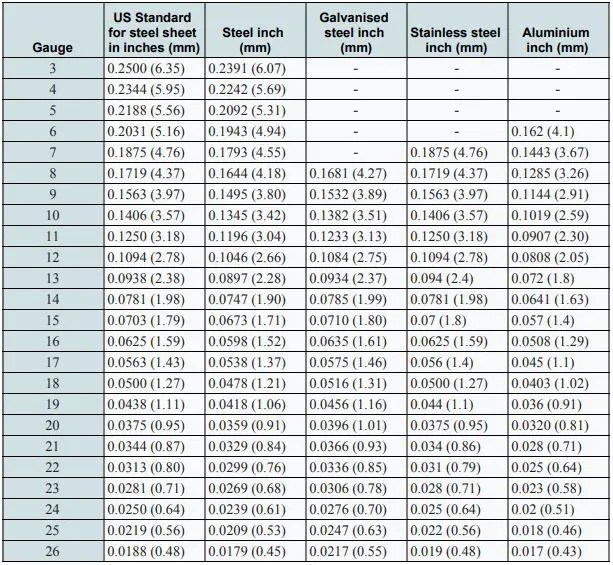Standard Steel Sheet Thickness
Standard Steel Sheet Thickness - Yet those numbers do not indicate a specific dimensional value. Below are sheet metal gauge charts for common metals. 16 gauge = 1.588 mm. Web below is our best attempt to capture all of the standard gauge thickness of different materials. Standard gauge size for sheet & plate iron / steel. For example, crca gauge number 11 is 3 mm thickness, whereas for aluminum 11 gauge is 2.23 mm.
Understanding these nuanced differences is vital when consulting a metal gauge chart to ensure that you're selecting the appropriate material for your endeavor. In the sheet metal fabrication industry, the term ‘gauge’ is used to specify the thickness or size of sheet metals. You’ll find the gauge and its corresponding thickness in inches and millimeters. Be sure to check with your supplier when purchasing steel what your actual thickness is going to be, especially if you’re receiving polished or treated material. Web get a quote.
In the sheet metal fabrication industry, the term ‘gauge’ is used to specify the thickness or size of sheet metals. 16 gauge = 1.29 mm. Web carbon steel, galvanized steel and stainless steel use the manufacturer’s standard gauge scale. This blog will help you out! Web sheet metal thickness (gauge) chart in inches gauge mild steel aluminum galvanized steel stainless.
When working with sheet metal, the term “gauge” is often used. By providing a standardized measurement system, it allows users to quickly determine the thickness based on gauge numbers. Web sheet metal gauge is a fundamental measurement in metalworking that denotes the thickness of sheet metal. The weight per unit area of the sheet can also be seen in pounds.
For the purpose of securing uniformity the following is established as the only standard gauge for sheet and plate iron and steel in the united states of america, namely: Web the chart below can be used to determine the equivalent sheet thickness, in inches or millimeters, for a gauge number from the selected gauge size standard. 16 gauge, 14 gauge,.
In australia, the typical thickness of sheet metal is between 0.5 millimetres and 6 millimetres. For the purpose of securing uniformity the following is established as the only standard gauge for sheet and plate iron and steel in the united states of america, namely: Web a sheet metal gauge or gage indicates the standard sheet metal thickness for a specified.
We also provide zinc sheets in sizes up to 3000mm x 1100mm and the standard metric 8ft x 4ft, with a maximum thickness of 1.5mm. This standard sheet & plate metal gauge size chart for iron and steel offers a clear overview of gauge sizes, each meticulously calibrated to denote varying thickness levels. Web sheet metal gauge is a fundamental.
Standard Steel Sheet Thickness - Anything thicker 6 millimetres is classified as metal plate, and anything. Find the proper measurement for your gauge size. Web standard gauges of sheet metal chart. Web the term gauge steel is often used to refer to the thickness of sheet metal made of steel. Standard gauge sizes were developed based on the weight of the sheet for a given material and the. If you are unfamiliar with the sheet metal industry or gauge system, you would be confused by the phrase ‘18 gauge steel’.
Understanding these nuanced differences is vital when consulting a metal gauge chart to ensure that you're selecting the appropriate material for your endeavor. 16 gauge = 1.613 mm. 16 gauge = 1.29 mm. Find the proper measurement for your gauge size. Metal gauge thickness & weight chart.
16 Gauge = 1.29 Mm.
Find the proper measurement for your gauge size. Standard gauge size for sheet & plate iron / steel. Be sure to check with your supplier when purchasing steel what your actual thickness is going to be, especially if you’re receiving polished or treated material. This blog will help you out!
Metal Gauge Thickness & Weight Chart.
Gauges indicate the material thickness of specific sheets. This chart compares gage numbers to their steel and aluminum sizing standards. Gauge are used to specify the thickness of a metal sheet. You’ll find the gauge and its corresponding thickness in inches and millimeters.
Originating From The Browne & Sharpe System In North America, Gauge Is A Standardized Unit Used To Specify The Thickness Of Metal Sheets, Plates, And Wire.
For example, 18 gauge steel, according to a gauge conversion chart, is 0.0478 inch or 1.214 millimeter. Web sheet metal gauge thickness chart ( to mm/inch comversation) standard steel. Web a gauge conversion chart can be used to determine the actual thickness of sheet metal in inches or millimeters. Commonly used metals for manufacturing at our shop are:
Anything Thicker 6 Millimetres Is Classified As Metal Plate, And Anything.
The weight per unit area of the sheet can also be seen in pounds per. What is the thickest and thinnest gauge of sheet metal? In the sheet metal fabrication industry, the term ‘gauge’ is used to specify the thickness or size of sheet metals. Web sheet metal thickness (gauge) chart in inches gauge mild steel aluminum galvanized steel stainless steel 3 0.2391 0.2294 0.2500 4 0.2242 0.2043 0.2344 5 0.2092 0.1819 0.2187 6 0.1943 0.1620 0.2031 7 0.1793 0.1443 0.1875 8 0.1644 0.1285 0.1680 0.1719 9 0.1495 0.1144 0.1532 0.1562




